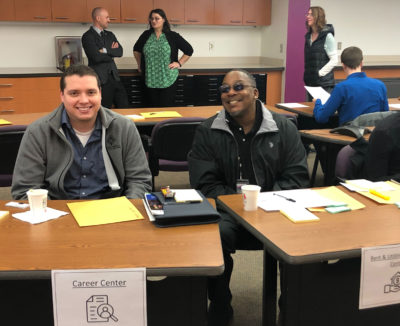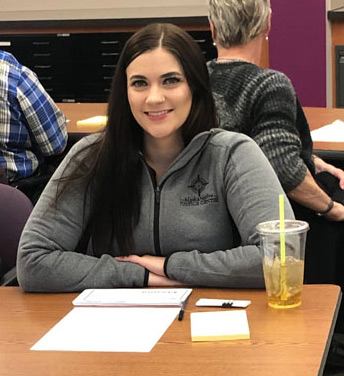Alaska’s first reentry simulation emphasizes the challenges of reentering society after leaving prison
Benjamin Briggs couldn’t buy a bus pass. He didn’t have enough money, and he couldn’t sell plasma at the local donation center because he didn’t feel well. With no pass, he missed work, which meant he got fired. With no job, he couldn’t pay for the urine analysis he was required to do for his parole officer. Before Benjamin knew it, he was back in prison after only a few moments of freedom.
Fortunately, he was released again after just a few minutes.
An Eye-Opening Experience

On April 17, the Anchorage Reentry Coalition held Alaska’s first reentry simulation, an event intended to build understanding of the real-world challenges faced by those exiting the prison system and trying to reenter the community.
“The intention is to raise awareness about how complicated reentry is after incarceration,” said Jonathan Pistotnik, Anchorage Reentry Coalition Coordinator, who led the effort to bring the simulation to Alaska. “If you don’t have a connection to someone who has been incarcerated, it’s easy to brush it off. But reentry is a community issue.”
Based on similar simulations held in the Lower Forty-Eight and adapted for Alaska by Jonathan and Yulonda Candelario from the U.S. Attorney’s Office, District of Anchorage, the event is meant to engage individuals who don’t necessarily have connections to the reentry community. Participants in the simulation are given a list of actual tasks that real-world reentrants have to complete upon being released from prison; tasks might include things like checking in with a probation officer, obtaining ID, finding employment, accessing social services and handling unexpected events.
As participants move through the activity, they find themselves running up against barriers that make reentry difficult and may even result in their return to prison.
“At the end of the event, the organizers asked how many participants ended up going back to jail,” said Benjamin, an Alaska Native Justice Center (ANJC) reentry case manager who volunteered at the April 17 simulation. “Nearly everyone had ended up back in jail because they couldn’t complete their tasks in the amount of time they were given. It’s an eye-opening experience.”
Barriers to Reentry
According to the Alaska Department of Corrections, 66.4 percent of Alaskans released from incarceration return to prison within three years of release. Two-thirds of those individuals return to custody within just six months.
“Reentry is a community issue.”
“The system is not set up for re-entrants to succeed,” explained Nayade Perez, a reentry program manager with ANJC who volunteered at the reentry simulation.
People who successfully reenter the community after being imprisoned do so because they have access to stabilizing factors, such as safe housing, employment, access to behavioral health services, and a positive, supportive network of family or friends. Without one or more of these resources, though, the likelihood that an individual reoffends and winds up back in prison increases.
While Anchorage offers resources through organizations like the Anchorage Reentry Coalition, Cook Inlet Tribal Council, and ANJC, said Jonathan, “Reentry after incarceration is complicated. It’s easy to overlook how a reentrant can be affected by something like going to the DMV — which, for most of us, is an easy task. But for someone coming back into society after years, it’s a real challenge. It assumes you have the time, that you know how to get there, that you have the money for fees. What if you don’t have a safe place to live? — how do you even have the capacity to take care of small tasks?”
The Reality of the Simulation

“When someone goes back to jail, it’s not because they want to reoffend,” explained Nayade, who said she experienced “flashbacks” at the April 17 simulation.
She volunteered as the banker at the event, handing out amounts of cash that didn’t seem like they would be enough for most participants to pay for all the items and tasks they needed to complete.
When Nayade was re-establishing her life after being released from jail eight years ago, something as simple as getting to an appointment on time would be an all-day effort. Busses often ran late, so Nayade would leave three hours early just to ensure she didn’t miss her appointments. She often spent several hours of her day just getting to and from somewhere.
“Within 30 days of release, you have so much to do, it’s overwhelming,” she said. “That’s why a lot of people don’t succeed.”
Engaging the Community
After the success of the April 17 simulation, the Anchorage Reentry Coalition is holding a second simulation on June 24 at the BP Energy Center. This time, said Jonathan, the target audience will include policy makers and people from sectors that don’t work in reentry.
“When someone goes back to jail, it’s not because they want to reoffend.”
“Engaging sectors like the business community, for example, is very important,” he elaborated. “They’re not a traditional partner in reentry, but our local businesses are the ones who might be hiring someone coming out of prison. They’re vital to the conversation.”
Employees of ANJC, including Benjamin and Nayade, will once again volunteer as bankers, parole officers, potential employers, and social service workers who present barriers to those participating. Yulonda will also help coordinate this second event. “Yulonda was key in making the first event happen,” said Jonathan. “She’s been my ally in making this a reality.
“When a reentrant succeeds, everyone in the community benefits from that success,” Yulonda said. “It only makes sense from a public safety and criminal justice standpoint that communities aid and guide reentrants into successful reentry.”
“We want to make this a regular activity, if we can,” he added. “We’re hopeful that as we refine it and make it more Alaska-specific, we can host the simulation with Fairbanks, the Mat-Su Valley, and other communities, as we continue the conversation about how to support reentrants in our state.”
